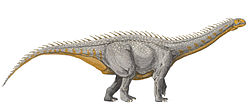| Histriasaurus Temporal range: Early Cretaceous, | |
|---|---|
 | |
| Vertebra from the holotype | |
| Scientific classification | |
| Domain: | Eukaryota |
| Kingdom: | Animalia |
| Phylum: | Chordata |
| Clade: | Dinosauria |
| Clade: | Saurischia |
| Clade: | † Sauropodomorpha |
| Clade: | † Sauropoda |
| Superfamily: | † Diplodocoidea |
| Family: | † Rebbachisauridae |
| Genus: | † Histriasaurus Dalla Vecchia, 1998 |
| Type species | |
| †Histriasaurus boscarollii Dalla Vecchia, 1998 | |
Histriasaurus (HIS-tree-ah-SAWR-us) (meaning "Istria lizard") is a genus of sauropod dinosaur from the Early Cretaceous (Hauterivian to Barremian stages, around 135-125 million years ago) of Croatia. It has been suggested to be a rebbachisaurid, and if so one of the oldest known members of the group.











